Great choice! Your favorites are temporarily saved for this session. Sign in to save them permanently, access them on any device, and receive relevant alerts.
- Sailboat Guide

Carter 37 (1 Ton)
Carter 37 (1 Ton) is a 37 ′ 0 ″ / 11.3 m monohull sailboat designed by Dick Carter and built by Olympic Marine starting in 1973.

Rig and Sails
Auxilary power, accomodations, calculations.
The theoretical maximum speed that a displacement hull can move efficiently through the water is determined by it's waterline length and displacement. It may be unable to reach this speed if the boat is underpowered or heavily loaded, though it may exceed this speed given enough power. Read more.
Classic hull speed formula:
Hull Speed = 1.34 x √LWL
Max Speed/Length ratio = 8.26 ÷ Displacement/Length ratio .311 Hull Speed = Max Speed/Length ratio x √LWL
Sail Area / Displacement Ratio
A measure of the power of the sails relative to the weight of the boat. The higher the number, the higher the performance, but the harder the boat will be to handle. This ratio is a "non-dimensional" value that facilitates comparisons between boats of different types and sizes. Read more.
SA/D = SA ÷ (D ÷ 64) 2/3
- SA : Sail area in square feet, derived by adding the mainsail area to 100% of the foretriangle area (the lateral area above the deck between the mast and the forestay).
- D : Displacement in pounds.
Ballast / Displacement Ratio
A measure of the stability of a boat's hull that suggests how well a monohull will stand up to its sails. The ballast displacement ratio indicates how much of the weight of a boat is placed for maximum stability against capsizing and is an indicator of stiffness and resistance to capsize.
Ballast / Displacement * 100
Displacement / Length Ratio
A measure of the weight of the boat relative to it's length at the waterline. The higher a boat’s D/L ratio, the more easily it will carry a load and the more comfortable its motion will be. The lower a boat's ratio is, the less power it takes to drive the boat to its nominal hull speed or beyond. Read more.
D/L = (D ÷ 2240) ÷ (0.01 x LWL)³
- D: Displacement of the boat in pounds.
- LWL: Waterline length in feet
Comfort Ratio
This ratio assess how quickly and abruptly a boat’s hull reacts to waves in a significant seaway, these being the elements of a boat’s motion most likely to cause seasickness. Read more.
Comfort ratio = D ÷ (.65 x (.7 LWL + .3 LOA) x Beam 1.33 )
- D: Displacement of the boat in pounds
- LOA: Length overall in feet
- Beam: Width of boat at the widest point in feet
Capsize Screening Formula
This formula attempts to indicate whether a given boat might be too wide and light to readily right itself after being overturned in extreme conditions. Read more.
CSV = Beam ÷ ³√(D / 64)
Production version of 1973 IOR One Ton Cup winner, ‘YDRA’. (1 ton was 27.5’, IOR MkIII) Drawing shown here is of the racing version. (from Carter Offshore flyer - courtesy of Mike Davies) More popular was another version with an extended wedge shaped coach roof and fitted out interior. At least one other Carter One ton design was introduced and went into production several years later from an American builder. (CARTER 36 OR TEXAS ONE TON?)
Embed this page on your own website by copying and pasting this code.
- About Sailboat Guide
©2024 Sea Time Tech, LLC
This site is protected by reCAPTCHA and the Google Privacy Policy and Terms of Service apply.
Review of Carter 37
Basic specs..
The hull is made of fibreglass. Generally, a hull made of fibreglass requires only a minimum of maintenance during the sailing season.
Unknown keel type
The keel is made of lead. Compared with iron, lead has the advantage of being 44% heavier, which allows a smaller keel and hence less water resistance and higher speed.
The boat can only enter major marinas as the draft is about 1.92 - 2.02 meter (6.30 - 6.60 ft) dependent on the load. See immersion rate below.
The boat is typically equipped with an inboard Perkins diesel engine at 50 hp (37 kW).
Sailing characteristics
This section covers widely used rules of thumb to describe the sailing characteristics. Please note that even though the calculations are correct, the interpretation of the results might not be valid for extreme boats.
The immersion rate is defined as the weight required to sink the boat a certain level. The immersion rate for Carter 37 is about 281 kg/cm, alternatively 1575 lbs/inch. Meaning: if you load 281 kg cargo on the boat then it will sink 1 cm. Alternatively, if you load 1575 lbs cargo on the boat it will sink 1 inch.
Sailing statistics
This section is statistical comparison with similar boats of the same category. The basis of the following statistical computations is our unique database with more than 26,000 different boat types and 350,000 data points.
What is L/B (Length Beam Ratio)?
What is a Ballast Ratio?
Maintenance
Are your sails worn out? You might find your next sail here: Sails for Sale
If you need to renew parts of your running rig and is not quite sure of the dimensions, you may find the estimates computed below useful.
| Usage | Length | Diameter | ||
| Mainsail halyard | 33.7 m | (110.5 feet) | 12 mm | (1/2 inch) |
| Jib/genoa halyard | 33.7 m | (110.5 feet) | 12 mm | (1/2 inch) |
| Spinnaker halyard | 33.7 m | (110.5 feet) | 12 mm | (1/2 inch) |
| Jib sheet | 11.2 m | (36.8 feet) | 14 mm | (0.55 inch) |
| Genoa sheet | 11.2 m | (36.8 feet) | 14 mm | (0.55 inch) |
| Mainsheet | 28.1 m | (92.1 feet) | 14 mm | (0.55 inch) |
| Spinnaker sheet | 24.7 m | (81.1 feet) | 14 mm | (0.55 inch) |
| Cunningham | 3.5 m | (11.6 feet) | 12 mm | (1/2 inch) |
| Kickingstrap | 7.1 m | (23.2 feet) | 12 mm | (1/2 inch) |
| Clew-outhaul | 7.1 m | (23.2 feet) | 12 mm | (1/2 inch) |
This section is reserved boat owner's modifications, improvements, etc. Here you might find (or contribute with) inspiration for your boat.
Do you have changes/improvements you would like to share? Upload a photo and describe what you have done.
We are always looking for new photos. If you can contribute with photos for Carter 37 it would be a great help.
If you have any comments to the review, improvement suggestions, or the like, feel free to contact us . Criticism helps us to improve.

- Forum Listing
- Marketplace
- Advanced Search
- About The Boat
- Boat Review Forum
- SailNet is a forum community dedicated to Sailing enthusiasts. Come join the discussion about sailing, modifications, classifieds, troubleshooting, repairs, reviews, maintenance, and more!
Gulfstar 37's Pro's & Cons
- Add to quote
I'm still new to sailing but in the next 5 years I'd like to end up living aboard and sailing mostly in the Pacific. I'm drawn to the Gulfstar 37's. I like the looks, inside and out. But at this point, I really don't know squat. I'd like to get some opinons on these boats...positive and negative. Thanks! Andy
They're great boats if you want to sit in a harbor, watch the bad weather roll in a stay dry while in the pilothouse, these are crappy boats to sail, like having a townhouse (the pilothouse) in your way all of the time, there are MUCH better boats, light winds they're like molasses in a Chicago winter.
Hi Denr, No offence, but it doesn't sound to me like you have EVER been on a Gulfstar 37. IF you were and it behaved as you have stated, the person sailing it did not know what they were doing. They are NOTHING like your description. Regards, Me
Denr, I think you have the Gulfstar 37 confused with other boats in their line. The 37 is a classic sailboat, no coachhouse. Gulfstar made a bunch of motor cruisers and sailboats that could have been called motor cruisers. But the 37 isn't one of them. It has a fin keel, skeg hung rudder, and a very nice layout for its era. I've spent years sailing one. First the pluses: - Reasonable performance for a cruiser. My '77 Gulfstar 37 easily outsailed an '89 Hunter 37 on a 6 hour port to port in the Great Lakes. It's no race sled, but it performs well for a cruiser. - Roomy cabin with tons of teak. Very pretty and comfortable if it's been maintained. - Fairly dry boat, the long bow overhand keeps the water off the deck and cockpit. Minuses: - The boats from the late '70's, early '80's have osmosis problems. We spent a long spring peeling the outer layer of glass off the hull and recoating with West Systems epoxy. - Over time, the lifeline stanchions leak. They'll need to be rebedded. - The engine is a challenge to access. Monkey-like abilities are a big plus. We loved our '37, but we finally got a bad case of 5'-itis and are moving up to a bigger boat. I'd be happy to fill in more details if you have more questions, let me know.
kvaavik said: I'd be happy to fill in more details if you have more questions, let me know. Click to expand...
good read thanks.. Looking at a 79
In case anyone is still linked to this thread: Why not post your questions and answers here instead of email? It's as easy as emailing, and all can benefit.
Yeah, I've never quite figured out why so many people come to a public forum like this one, where the whole idea is to share information with the community, and then want to take all of their discussions to PM or e-mail.
Hi, I too have been looking for a 37 Gulfstar. From what I have read it's hard to beat for a reasonably priced cruiser. Any words of wisdom from past owners?
I own a 1979 Gulfstar 37 that I purchased in 1990 and love the boat. My wife and 2 children, now grown, have sailed on it every season (Apr-Oct) here in New England and have spent two weeks at a time on it comfortably. That being said, I have seen earlier built GF37s that almost don't seem to be quite the same boat somehow although that's purely a value judgement on my part. I have hull #139 so hopefully all the kinks were worked out earlier. But to the point, the '79 GS37 is a well built and forgiving vessel under sail. All bulkheads are tabbed, the interior is roomy and storage space abounds. We have been in 35 k winds and 12' seas off Nantucket (not by choice) and the question on my mind was whether the crew would hold up not the boat. I had a double reefed main, with the head sail furled to 1/3 and 'Windchime' my vessel, wasn't even breathing hard as she just kept charging powerfully ahead. The GS37s wide beam is carried all the way to the stern allowing for deep storage lockers, huge interior for a 37', (people can't believe it's only 37') and it's extended waterline allows for a comfortable sail in big seas. The teak joinery is masterfully done, and the vessel is extremely safe and forgiving. The biggest drawback is access to the engine but it's not unmanageable. People are surprised at the roominess below and the spacious comfortable cockpit. I love the boat. Just be sure to check for osmosis since I've heard horror stories about that on earlier ones. The deciding factgor for me was the fact that Ted Hood was the sole distributor for GS37s in the NE and he wouldn't be selling a poorly made or one that didn't sail well. I think I was right. I still own the boat and I'm getting ready to commission it for the coming season. Hope this helps you.
I've been living aboard a 1979 Gulfstar 37 for about 3 years now in Boston and I love it. She's a surprisingly fast boat, I regularly exceed 8kts and have maintained upwards of 7.5kts for extended periods. I think the interior is beautiful and roomy. It's also surprisingly warm in the winter; the teak interior and the airspace behind it act as insulation. I really like the L-shaped nav station which has a ton of room (I have my computer set up on it). The lazarettes are cavernous. Mine did not have any blister problems, but just to be safe I had the bottom barrier coated. My deck has not suffered any water intrusion, perhaps a previous owner took care of rebedding the stanchions. The engine access isn't great, but it isn't terrible, either. My biggest complaint is the V-berth... it gets a little narrow towards the bow. My girlfriend likes to stretch out. That is going to be the driving force behind me getting a bigger boat, I think.
Just read the latest issue of Practical Sailor April 2013, not to many kind words to be said about a pre-1980 Gulfstar boats. I always thought that they were well built, not now. I think i would avoid them now. Then again; the more i learn about 70's boats the more i learn that a lot of them are not as well-built as people claim.
Bene, I have not read the article you refer to, as I am not a subscriber, but I do know that Gulfstar went through three distinct phases (I know a guy who used to work for them, both at the yard and as a broker). In the first phase, they produced a bunch of crappy motorsailers and power boats. Then they started producing well-built and good-performing sailboats -- this was from around 1976 - 1984. After that, for reasons unknown they began to cut corners and the quality of construction went significantly downhill. I lucked into buying a boat from the good period in the middle, and now knowing what I know, I'd be entirely comfortable buying another one -- my boat is extremely solid. I would not buy a boat from either of their two bad periods.
Haven't read the article Bene is referring to but I love my 1979 Gulfstar 37. It was delivered to Ted Hood who was the sole distributor for them here in the NE. I even have the delivery papers and itemized mfg hardware list . That being said, I've seen earlier built GF 37s that don't have anywhere near the quality does mine and and many other owners. It's a great boat. Roomy, beamy, fast, forgiving and comfortable. I wouldn't dismiss it without checking first checking it out.
Hey Andy, I'm interested in a 77 gulfstar 37 myself for a very similar idea as yours (live in and possible circumnavigation). Wondering what you ended up going with and how it all went? Thank you in advance Best Regards, Zee
- ?
- 176.3K members
Top Contributors this Month
- Yachting Monthly
- Digital edition

- July 9, 2009
Introduced to the UK in 1974, this IOR-derived cruiser was from the prolific and innovative board of American Dick Carter. Northshore Yachts built the first batch as racers, with a large cockpit and bigger sailplan, but when racing success dried up, the company produced a second version with a smaller cockpit, less sail area and a fully-fitted interior with a conventional but effective five-berth layout. In this format she was well built and finished, and made a good fast cruiser with excellent handling. Production moved to Poland in 1979 and was continued by Teliga until 1988, as the Teliga 30. More than 400 were built in all. Polish quality was variable and the interior joinery in particular varied from adequate to poor. New boat prices were low and second-hand values should reflect this. There were also some home-built British boats.
LOA 9.08m (29ft 9in), LWL 7.01m (23ft), beam 3.06m (10ft 1in), draught 1.68m (5ft 6in) displacement 3,084kg (6,800lb). Price guide: YM Test Report November 1998.

1974 Carter 37 Technical Specs
General data about carter 37.
| Brand | |
| Model | |
| Boat Type | |
| Category | |
| Year Of Production | |
| Condition (New/Used) | |
| Country | |
| Fuel (Gas/Diesel) | |
| Hull Material Used | |
| Length | |
| Selling Price | |
Engine and Power Specs
| Engine manufacturer | |
| Engine Series | |
| Engine Location | |
| Engine Hours | |
| Engine Horsepower | |
| Engine Drive | |
| Engine Built Year | |
| Boat Propeller |
Dimensions And Wieght
| Minimum Draft | |
| LOA (Length Overall) | |
| L.W.L(Length WaterLine) | |
| Boat Maximum Draft | |
| Beam Width |
Detailed Specifications
| Numebr of Cabins | |
| Number of Heads (Watercraft) | |
| Gas Tank Size | |
| Drinking Water Tank | |
| Anchor Windlass |
Features And Equipments
Sailing features.
| Storm jib |
| Spinnaker |
| Fully battened mainsail |
Other Equipments
| Spinnaker pole |
| Furling genoa |
Interior Specifications
| Toilet head |
| Oven and cooktop |
| Marine refrigerator |
| Marine battery charger |
| Hand bilge pump |
| Automatic bilge pump |
Exterior Features
| Teak cockpit |
| Safety life raft |
| Lazy bag |
| Inflatable tender |
Electronical And Electrical Info
| Vhf radio |
| Speed log |
| Repeater |
| Radar detector |
| Navigation center |
| Marine wind instruments |
| Marine gps |
| Depth sounder instrument |
| Compass steering |
| Autopilot system |
Deck Hardware
| Tiller |

- Carter provided us with the latest version of its 37 service repair manual
- Find All mechanical and electrical parts and accessories of Carter 37 Sail here
Carter 37 competitors

- Olimpic Yacht
Carter 37 - Olimpic Yacht / STW003555
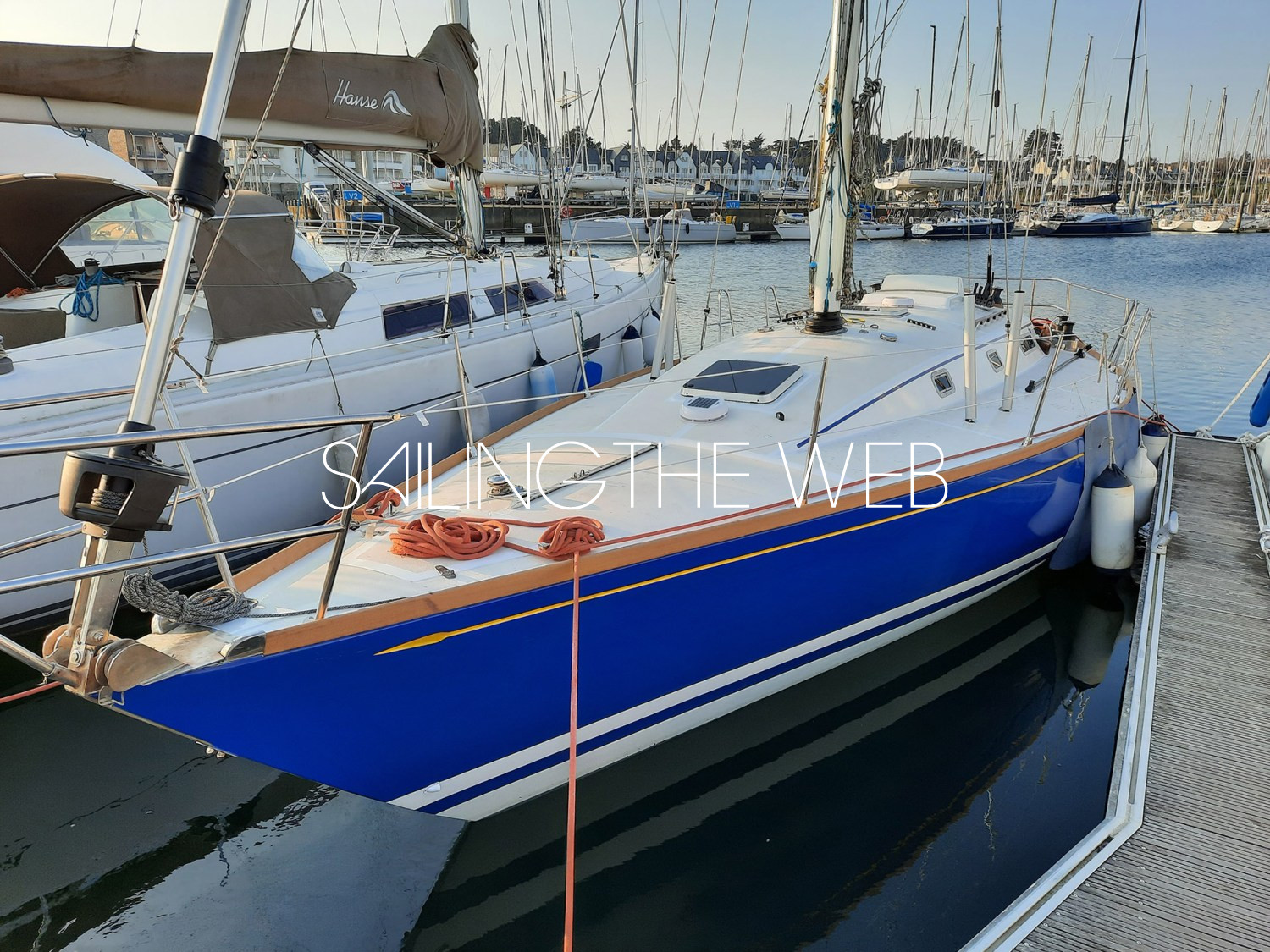
The Carter 37 produced by the builder Olimpic Yacht and designed by Dick Carter, is a cabin cruiser for cruising/regatta, rigged Sloop
Technical data

cabin cruiser
cruising/regatta
Perkins 50 HP
overall length
hull length
waterline length
standard draft
minimum draft
displacement
diesel tank
mast height
Accomodation layouts
standard version
DOCUMENTS: Carter 37
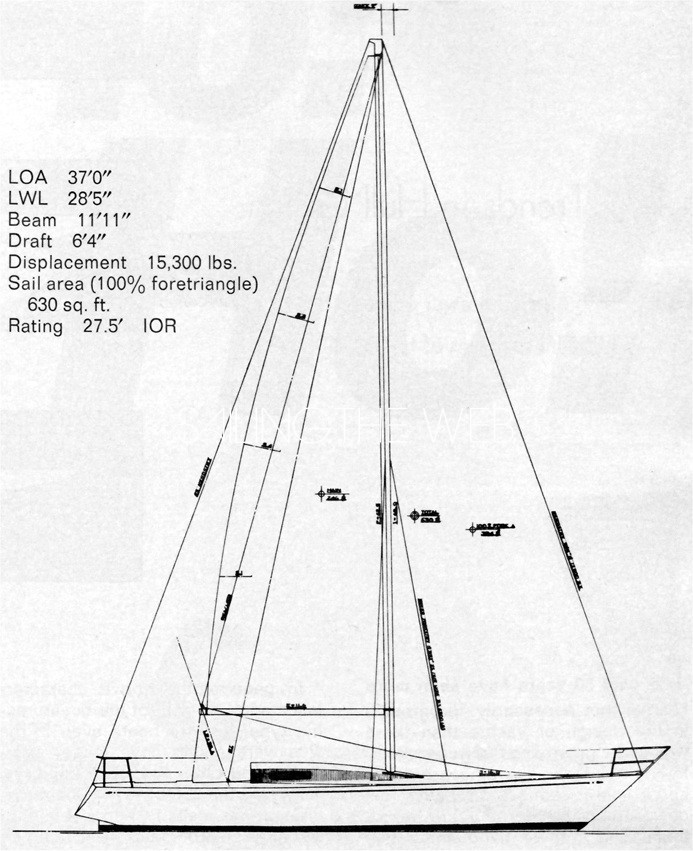
Drawings: sailplan, accomodation layout, hull drawing
pdf file pretty good resolution
If you find some wrong or lacking data of this boat, you can propose an update.
Technical forum: carter 37, note: you will be redirected to another website., support the ultimate sailboat database.
The contents on this website, which today you can simply consult and use, have been collected, organized and archived by people who worked and invested in this project with passion and dedication for many years.
Before proceeding to browse, support our archive with a small donation that will allow us to maintain and improve this project.
proceed, I will donate next time
To proceed, you need to sign-in
Visit our Popular Forums
- Monohull Sailboats
- Multihull Sailboats
- Powered Boats
- General Sailing
- Antares Yachts
- Fountaine Pajot
- Lagoon Catamarans
Cruising Business
- Boat Classifieds
- General Classifieds
- Crew Positions
- Commercial Posts
- Vendor Spotlight
Life Aboard a Boat
- Provisioning: Food & Drink
- Families, Kids, & Pets Afloat
- Recreation, Entertainment, & Fun
- Boat Ownership & Making a Living
- Liveaboard's Forum
Seamanship, Navigation & Boat Handling
- Seamanship & Boat Handling
- Training, Licensing, & Certification
- Health, Safety, & Related Gear
- Rules of the Road, Regulations, & Red Tape
Engineering & Systems
- Const. / Maint. / Refit
- Product / Service Reviews
- Electronics: Comms / AV
- Electrical: Batts / Gen / Solar
- Lithium Power Systems
- Engines & Propulsion
- Propellers & Drive Systems
- Plumbing / Fixtures
- Deck Hdw: Rigging / Sails
- Aux. Equipment & Dinghy
- Anchoring & Mooring
Photo Categories
- Member Galleries
- Life Onboard
- Sailing in the Wind
- Power Boats
- Cruising Destinations
- Maint. & Boat Building
- Marine Life
- Scuba Diving & Divers
- General Photos
Recent Photos

Listing Categories
- African Cats
- view more »
- Crew Wanted
- Crew Available
- Enhance Your Account
- Meet the Mods
- Meet the Advisors
- Signup for The Daily Cruiser Email

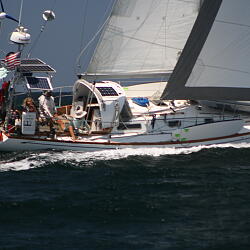
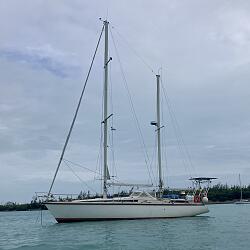



































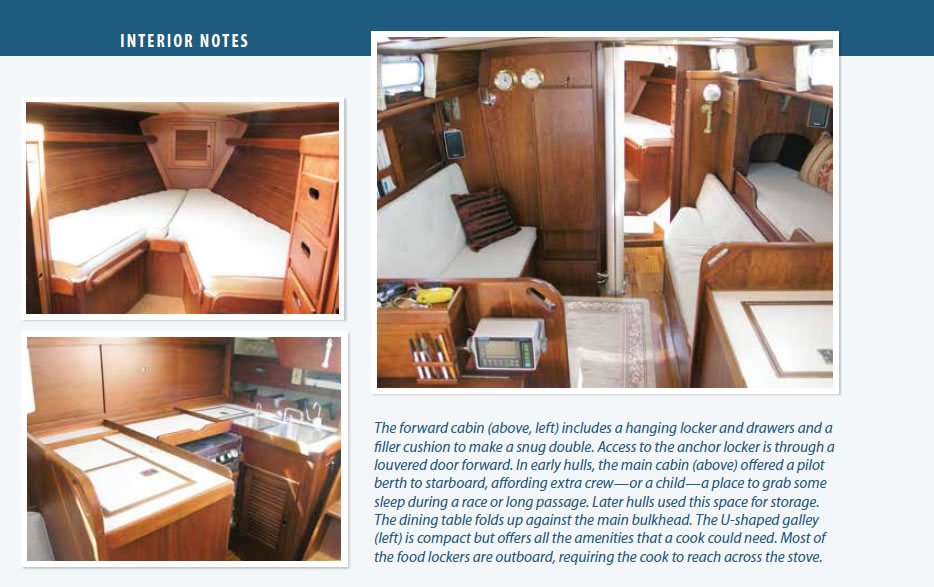





IMAGES
VIDEO
COMMENTS
Carter 37 thoughts. Hi to all I am interested in buying a carter 37 from the mid 70s for cruising and possibly offshore cruising. If any body out there has any experience of sailing these boats I would love to hear your thoughts of there pluses and minuses. Also does anyone know why most of the information in can find is in French when the ...
Production version of 1973 IOR One Ton Cup winner, 'YDRA'. (1 ton was 27.5', IOR MkIII) The production version has an extended wedge shaped coach roof and fitted out interior. The photo and drawing of the production version, courtesy of Philippe Jacques ROUX. At least one other Carter One ton design was introduced and went into production ...
Carter 37 (1 Ton) is a 11.3 m monohull sailboat designed by Dick Carter and built by Olympic Marine starting in 1973. Designer.
The immersion rate is defined as the weight required to sink the boat a certain level. The immersion rate for Carter 37 is about 281 kg/cm, alternatively 1575 lbs/inch. Meaning: if you load 281 kg cargo on the boat then it will sink 1 cm. Alternatively, if you load 1575 lbs cargo on the boat it will sink 1 inch.
American designer and racing sailor. His first notoriety was achieved with the 33′ 'Rabbit', which trounced the competition on the European racing circuit in 1965, including a first overall in the Fastnet race. He returned the following year with the 37′ 'Tina', with nearly equal success. Carter designs continued to dominate RORC handicap racing for a number of years with 'Rabit ...
First the pluses: - Reasonable performance for a cruiser. My '77 Gulfstar 37 easily outsailed an '89 Hunter 37 on a 6 hour port to port in the Great Lakes. It's no race sled, but it performs well for a cruiser. - Roomy cabin with tons of teak.
Yachting Monthly. July 9, 2009. 0 shares. Carter 30. Introduced to the UK in 1974, this IOR-derived cruiser was from the prolific and innovative board of American Dick Carter. Northshore Yachts built the first batch as racers, with a large cockpit and bigger sailplan, but when racing success dried up, the company produced a second version with ...
1974 Carter 37 Technical Specs. General Data about Carter 37. Brand: Carter: Model: 37: Boat Type: Sail: Category: Cruiser (Sail) Year Of Production: 1974: Condition (New/Used) Pre-Owned (Used) Country: La Forêt Fouesnant, Finistère, France : Fuel (Gas/Diesel) Diesel : Hull Material Used: Fiberglass :
If you find some wrong or lacking data of this boat, you can propose an update. TECHNICAL FORUM: Carter 37. The Carter 37 produced by the builder Olimpic Yacht and designed by Dick Carter, is a cabin cruiser for cruising/regatta, rigged Sloop ... read more on Sailing The Web, the ultimate sailboat database.
Here's what we said about the design in our Nov. 15, 1980 review: "The boat has a swept-back, fairly high-aspect-ratio keel of the type made popular by IOR racing boats in the early 1970s. The high aspect ratio spade rudder is faired into the underbody with a small skeg. The boat is conventionally modern in appearance.
Alberg 37 opinions. In my long search for a cruising boat with offshore potential, I have looked at everything from a Hullmaster 27 (small but tough) to a Ingrid 38, and lots in between. I had been narrowing in on the 30-32 size as the most practical for a couple to handle, but then an Alberg 37 in my price range came up. (asking $28K CAD).
Aug 21, 2017. Original: Aug 22, 2014. A Big Little Sistership: An able 37-foot cruiser with lots of space and an easy-to-handle rig. The Hunter 37 is effectively a smaller sistership to the Hunter 40, which was introduced in something of a rush in 2012 as Marlow Hunter—formerly Hunter Marine—celebrated its 40th birthday and a change of ...
This 1974 vintage beauty has undertaken a 2021 total refit. All but the hull and mast is completely new! You get a vintage boat that attracts the attention in every marina with all modern systems and amenities as if it was a 2021 boat! Mast is painted and with new wires. All wood with new shiny varnish. Hull with 3M shine white film. The whole
Sailboat CARTER 37 (1 TON) 1973 - Arrow. Sailboat information Blog mentions. Yacht description. Arrow is a cruise ready, sweet sailing, seaworthy yacht from a classic period of yachting history. With a moderate ballast to displacement ratio, Arrow is a great light air boat while at the same time maintains a kind motion in a seaway. Her large ...
1. The Tartan 37 is a moderately high performance, shoal-draft cruiser built between 1967 and 1988 by Tartan Marine, a company that helped usher in the fiberglass era under Charlie Britton in the 1960s. At the time of the Tartan 37s introduction, the company had its headquarters in Grand River, Ohio, and a factory in Hamlet, N.C.
Along with the CARTER 30, the CARTER 33 is one of the most popular of the designers 'series built' boats. They were available through his company Carter Offshore and built primarily in Greece. The same design was also built in Australia, and Sweden. (A version of the CARTER 33, with shorter rig, did fall within the RORC 1/2 ton threshold - 21.7'.)
Description: Olympics Yachts (Greece) - CARTER 37 - The CARTER 37 was praised by the specialized press as a fast and solid racing-cruising sailboat. Her wide genoa and her low freeboard make her a particularly elegant sailboat that attracts attention. Its lead ballast of 2.85 t makes it a stiff and safe sailboat. Mustang benefited from two major work stoppages in 2006-2007 and 2020-2021 ...
Company Registration Nr: 11835484 VAT Registration Nr: 331451241. Marine Data Cloud Ltd Registered in England & Wales at 71-75, Shelton Street, Covent Garden, London, WC2H 9JQ, UK
1974 Carter 37 for sale. Used 1974 Carter 37 for sale is located in Municipal District of Carrigaline (Munster, Ireland).This vessel was designed and built by the Carter shipyard in 1974. Key features 1974 Carter 37: length 10.97 meters. engine: fuel type - diesel. 1974 Carter 37 refers to classes: sailing yachts, sailboats and sailing sloops.To clarify the price €29,750 and buy Carter 37 ...
This vessel was designed and built by the Carter shipyard in 1974. Key features 1974 Carter 37: length 11.2 meters and beam 3.66 meters. Hull key features 1974 Carter 37: keel type - other keel. 1 x Volvo engine: engine hours - 1750 hours and fuel type - diesel. 1974 Carter 37 refers to classes: sailing sloops and sailboats.
The IRWIN 37 was promoted as a no compromise cruising boat. Introduced in 1971 it was one of this builders most successful models though undergoing numerous changes until production ended in 1982. It's been said that nearly nearly 600 were sold. Available as sloop, cutter or ketch. KEEL OPTIONS: Shoal draft fixed keel: 4.92′ Keel/cb […]